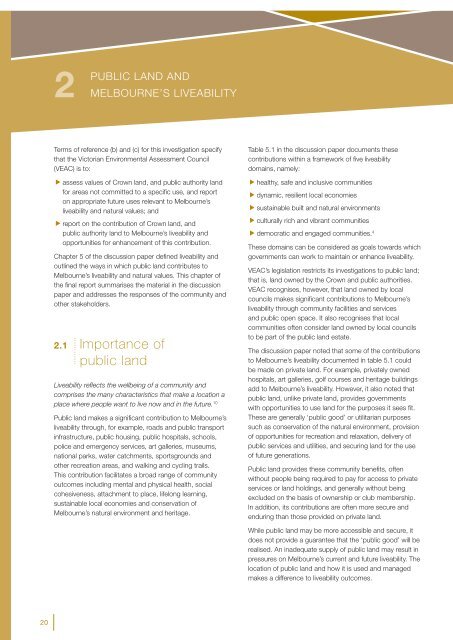Metropolitan Melbourne Investigation - Victorian Environmental ...
Metropolitan Melbourne Investigation - Victorian Environmental ...
Metropolitan Melbourne Investigation - Victorian Environmental ...
Create successful ePaper yourself
Turn your PDF publications into a flip-book with our unique Google optimized e-Paper software.
2<br />
PUBLIC<br />
LAND AND<br />
MELBOURNE’S LIVEABILITY<br />
Terms of reference (b) and (c) for this investigation specify<br />
that the <strong>Victorian</strong> <strong>Environmental</strong> Assessment Council<br />
(VEAC) is to:<br />
G assess values of Crown land, and public authority land<br />
for areas not committed to a specific use, and report<br />
on appropriate future uses relevant to <strong>Melbourne</strong>’s<br />
liveability and natural values; and<br />
G report on the contribution of Crown land, and<br />
public authority land to <strong>Melbourne</strong>’s liveability and<br />
opportunities for enhancement of this contribution.<br />
Chapter 5 of the discussion paper defined liveability and<br />
outlined the ways in which public land contributes to<br />
<strong>Melbourne</strong>’s liveability and natural values. This chapter of<br />
the final report summarises the material in the discussion<br />
paper and addresses the responses of the community and<br />
other stakeholders.<br />
2.1 Importance of<br />
public land<br />
Liveability reflects the wellbeing of a community and<br />
comprises the many characteristics that make a location a<br />
place where people want to live now and in the future. 10<br />
Public land makes a significant contribution to <strong>Melbourne</strong>’s<br />
liveability through, for example, roads and public transport<br />
infrastructure, public housing, public hospitals, schools,<br />
police and emergency services, art galleries, museums,<br />
national parks, water catchments, sportsgrounds and<br />
other recreation areas, and walking and cycling trails.<br />
This contribution facilitates a broad range of community<br />
outcomes including mental and physical health, social<br />
cohesiveness, attachment to place, lifelong learning,<br />
sustainable local economies and conservation of<br />
<strong>Melbourne</strong>’s natural environment and heritage.<br />
Table 5.1 in the discussion paper documents these<br />
contributions within a framework of five liveability<br />
domains, namely:<br />
G healthy, safe and inclusive communities<br />
G dynamic, resilient local economies<br />
G sustainable built and natural environments<br />
G culturally rich and vibrant communities<br />
G democratic and engaged communities. 4<br />
These domains can be considered as goals towards which<br />
governments can work to maintain or enhance liveability.<br />
VEAC’s legislation restricts its investigations to public land;<br />
that is, land owned by the Crown and public authorities.<br />
VEAC recognises, however, that land owned by local<br />
councils makes significant contributions to <strong>Melbourne</strong>’s<br />
liveability through community facilities and services<br />
and public open space. It also recognises that local<br />
communities often consider land owned by local councils<br />
to be part of the public land estate.<br />
The discussion paper noted that some of the contributions<br />
to <strong>Melbourne</strong>’s liveability documented in table 5.1 could<br />
be made on private land. For example, privately owned<br />
hospitals, art galleries, golf courses and heritage buildings<br />
add to <strong>Melbourne</strong>’s liveability. However, it also noted that<br />
public land, unlike private land, provides governments<br />
with opportunities to use land for the purposes it sees fit.<br />
These are generally ‘public good’ or utilitarian purposes<br />
such as conservation of the natural environment, provision<br />
of opportunities for recreation and relaxation, delivery of<br />
public services and utilities, and securing land for the use<br />
of future generations.<br />
Public land provides these community benefits, often<br />
without people being required to pay for access to private<br />
services or land holdings, and generally without being<br />
excluded on the basis of ownership or club membership.<br />
In addition, its contributions are often more secure and<br />
enduring than those provided on private land.<br />
While public land may be more accessible and secure, it<br />
does not provide a guarantee that the ‘public good’ will be<br />
realised. An inadequate supply of public land may result in<br />
pressures on <strong>Melbourne</strong>’s current and future liveability. The<br />
location of public land and how it is used and managed<br />
makes a difference to liveability outcomes.<br />
20
















